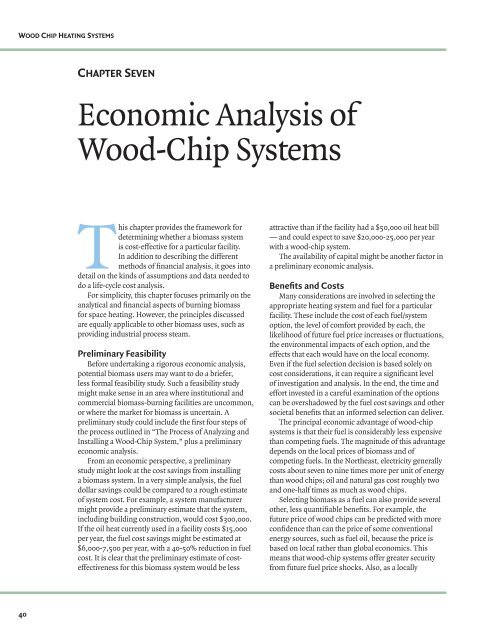Wood-Chip Heating Systems - Biomass Energy Resource Center
Wood-Chip Heating Systems - Biomass Energy Resource Center
Wood-Chip Heating Systems - Biomass Energy Resource Center
You also want an ePaper? Increase the reach of your titles
YUMPU automatically turns print PDFs into web optimized ePapers that Google loves.
WOOD CHIP HEATING SYSTEMS<br />
40<br />
CHAPTER SEVEN<br />
Economic Analysis of<br />
<strong>Wood</strong>-<strong>Chip</strong> <strong>Systems</strong><br />
This chapter provides the framework for<br />
determining whether a biomass system<br />
is cost-effective for a particular facility.<br />
In addition to describing the different<br />
methods of fi nancial analysis, it goes into<br />
detail on the kinds of assumptions and data needed to<br />
do a life-cycle cost analysis.<br />
For simplicity, this chapter focuses primarily on the<br />
analytical and fi nancial aspects of burning biomass<br />
for space heating. However, the principles discussed<br />
are equally applicable to other biomass uses, such as<br />
providing industrial process steam.<br />
Preliminary Feasibility<br />
Before undertaking a rigorous economic analysis,<br />
potential biomass users may want to do a briefer,<br />
less formal feasibility study. Such a feasibility study<br />
might make sense in an area where institutional and<br />
commercial biomass-burning facilities are uncommon,<br />
or where the market for biomass is uncertain. A<br />
preliminary study could include the fi rst four steps of<br />
the process outlined in “The Process of Analyzing and<br />
Installing a <strong>Wood</strong>-<strong>Chip</strong> System,” plus a preliminary<br />
economic analysis.<br />
From an economic perspective, a preliminary<br />
study might look at the cost savings from installing<br />
a biomass system. In a very simple analysis, the fuel<br />
dollar savings could be compared to a rough estimate<br />
of system cost. For example, a system manufacturer<br />
might provide a preliminary estimate that the system,<br />
including building construction, would cost $300,000.<br />
If the oil heat currently used in a facility costs $15,000<br />
per year, the fuel cost savings might be estimated at<br />
$6,000-7,500 per year, with a 40-50% reduction in fuel<br />
cost. It is clear that the preliminary estimate of costeffectiveness<br />
for this biomass system would be less<br />
attractive than if the facility had a $50,000 oil heat bill<br />
— and could expect to save $20,000-25,000 per year<br />
with a wood-chip system.<br />
The availability of capital might be another factor in<br />
a preliminary economic analysis.<br />
Benefi ts and Costs<br />
Many considerations are involved in selecting the<br />
appropriate heating system and fuel for a particular<br />
facility. These include the cost of each fuel/system<br />
option, the level of comfort provided by each, the<br />
likelihood of future fuel price increases or fl uctuations,<br />
the environmental impacts of each option, and the<br />
effects that each would have on the local economy.<br />
Even if the fuel selection decision is based solely on<br />
cost considerations, it can require a signifi cant level<br />
of investigation and analysis. In the end, the time and<br />
effort invested in a careful examination of the options<br />
can be overshadowed by the fuel cost savings and other<br />
societal benefi ts that an informed selection can deliver.<br />
The principal economic advantage of wood-chip<br />
systems is that their fuel is considerably less expensive<br />
than competing fuels. The magnitude of this advantage<br />
depends on the local prices of biomass and of<br />
competing fuels. In the Northeast, electricity generally<br />
costs about seven to nine times more per unit of energy<br />
than wood chips; oil and natural gas cost roughly two<br />
and one-half times as much as wood chips.<br />
Selecting biomass as a fuel can also provide several<br />
other, less quantifi able benefi ts. For example, the<br />
future price of wood chips can be predicted with more<br />
confi dence than can the price of some conventional<br />
energy sources, such as fuel oil, because the price is<br />
based on local rather than global economics. This<br />
means that wood-chip systems offer greater security<br />
from future fuel price shocks. Also, as a locally





